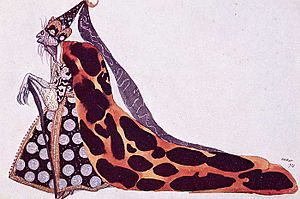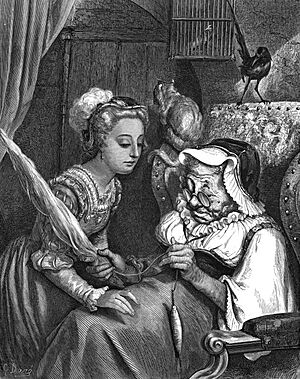Wicked fairy godmother facts for kids

The Wicked Fairy Godmother is a famous character in fairy tales. She is best known from the story of Sleeping Beauty. In this tale, she casts a bad spell on the princess. She is sometimes called Carabosse or, in Walt Disney movies, Maleficent.
Contents
Where the Wicked Fairy Came From
The oldest known version of Sleeping Beauty is called Sun, Moon, and Talia. It was written by Giambattista Basile. In this early story, there are no fairy godmothers. The princess's future is predicted, but no magic causes it.
Charles Perrault added the fairy to his version of Sleeping Beauty in 1697. He did not give her a name. The Brothers Grimm also included a similar fairy in their story, "Little Briar Rose." In Perrault's tale, seven good fairies were invited to the princess's christening. The wicked fairy was the eighth, uninvited guest. In the Grimms' story, twelve good fairies were invited, and the wicked one was the thirteenth.
The idea of a wicked fairy appeared even before Perrault's story. In an old French poem called Les Prouesses et faitz du noble Huon de Bordeaux, the elf-king Oberon explains that an angry fairy cursed him to be small. Later, in stories by Madame d'Aulnoy, a wicked fairy named "Carabosse" appeared. This name became popular for the wicked fairy in Sleeping Beauty after Marius Petipa's ballet Sleeping Beauty.
Her Role in the Story

In Sleeping Beauty, the wicked fairy godmother arrives at the princess's christening without an invitation. She is very angry about this. She declares that when the princess turns fifteen, she will prick her finger on a spindle and die. A good fairy then changes the curse. Instead of dying, the princess will only fall into a deep sleep. To protect her, the king tries to get rid of all spindles.
On her fifteenth birthday, the princess finds an old woman spinning. She pricks her finger on the spindle and falls into a deep sleep. In some older versions, the old woman is just a normal person. But in newer versions, like Tchaikovsky's ballet, the spinning woman is the wicked fairy Carabosse herself. She makes sure her curse comes true.
The Ballet Version
In Marius Petipa's ballet Sleeping Beauty, Carabosse is a scary character. She enters the stage with dramatic and spooky music. Her costumes, designed by Léon Bakst, often made her look like a rat.
In a modern version by Matthew Bourne, the king and queen ask Carabosse for help to have a child. She gives them a daughter, Aurora. But the king forgets to thank her, so she curses the child. Years later, Carabosse dies, but her son tries to get revenge on Aurora.
Disney's Maleficent
In the 1959 Disney animated movie Sleeping Beauty, the wicked fairy is named Maleficent. She is a powerful and evil character. Like in the older stories, she curses Princess Aurora because she wasn't invited to the christening. Maleficent says Aurora will die on her sixteenth birthday.
The three good fairies soften the curse. Aurora will only fall into a deep sleep. To keep her safe, the good fairies take baby Aurora to live in the woods. King Stefan, Aurora's father, orders all spinning wheels to be burned.
On her sixteenth birthday, Aurora returns to the palace. Maleficent magically creates a spinning wheel, and Aurora pricks her finger. When Maleficent learns that Prince Phillip loves Aurora, she captures him. She wants him to be too old to save Aurora. But the good fairies help Prince Phillip escape. Maleficent then turns into a giant black dragon to fight him. Prince Phillip defeats her with his Sword of Truth, ending her evil.
In the 2014 movie Maleficent, the story changes. Maleficent is shown as a sad villain. She curses Aurora to get revenge on King Stefan, who hurt her. But Maleficent starts to care for Aurora like her own child. In the end, her true love's kiss breaks the curse. This shows Maleficent's journey to becoming good.
Newer Versions of the Tale
Many writers have created new or "revisionist" versions of the wicked fairy godmother. These stories often make fun of or change the original tale.
For example, in the movie Shrek 2, a tricky Fairy Godmother appears. She tries to make her son, Prince Charming, marry the princess.
In George MacDonald's story The Light Princess, the king's sister, Princess Makemnoit, is not invited to the christening. She curses the princess to have no gravity, making her float. Makemnoit later tries to stop all water from existing, but she drowns when her house falls into the water.
In Robin McKinley's Spindle's End, the wicked fairy is named Pernicia. She curses the princess, Rosie, to fall into a deathly sleep on her 21st birthday. A powerful fairy switches Rosie's identity with her friend Peony to break the spell.
The wicked fairy also appears in Jetlag Productions' Sleeping Beauty, named Odelia. She curses Princess Felicity to die after her sixteenth birthday. Odelia disguises herself as an old spinning woman. Prince Richard eventually breaks Odelia's spell and ends her life.

